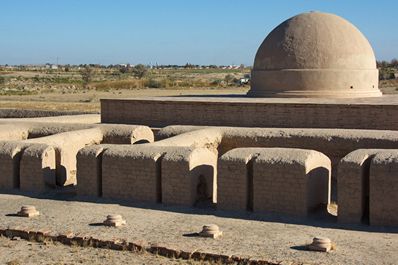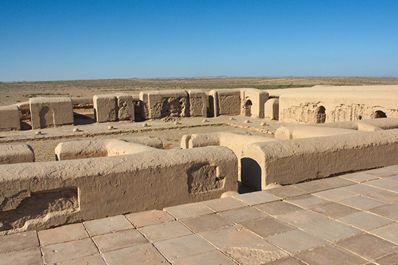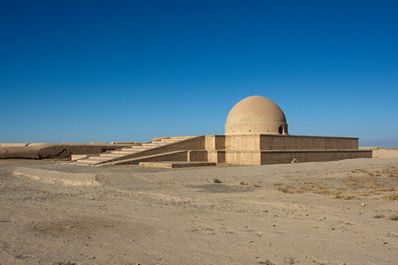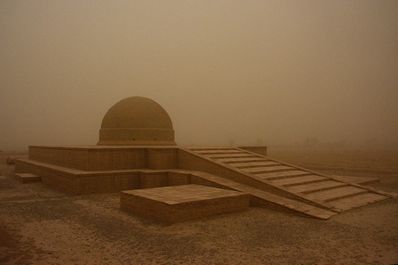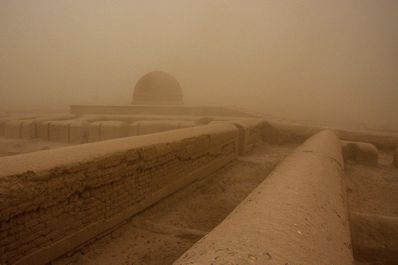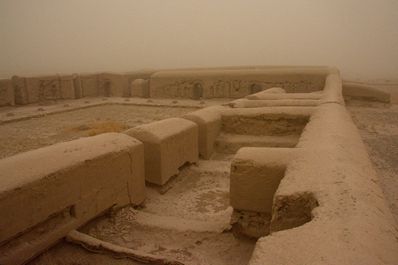遗产数据库
法亚兹特佩佛教寺院遗址Fayaz Tepe
Architectural monuments of Termez - Buddhist temple Fayaz -Tepa
From ancient times the territory of Central Asia has been a crossing point not only of many caravan roads and ways, but also a place where different religions coexisted in ancient times: Zoroastrianism, Buddhism, Manichaeism. At present, several Buddhist temples survived in Uzbekistan. Among the most famous are Airatam, Kara-Tepa and Fayaz-Tepa.
Fayaz-Tepa complex was discovered in 1963 by the archaeologist L. Albaum during excavations near the Buddhist temple on the Kara-Tepa hill in the heart of the old Termez. This temple complex is characterized by rich paintings and well-preserved sculptures. The complex is U-shaped series of corridors, cells and sanctuaries. Separately, there is a Buddhist dagoba, which is also of great interest.
The building itself can be divided into three parts. One part is accommodation and ancillary buildings. Another one was the original dining room with kitchen, and a third one was used for performance of religious rites. Fayaz-Tepa is not only an iconic monument of Buddhism in Central Asia, but also of great value as one of the few monuments of Buddhist pictural art, which adorns the walls of the complex.
The walls along the temple were covered with paintings depicting the Buddha image variations. The walls of the sanctuary were decorated with images and story lines, one of which is the image of the two Buddhas, with images of women on both sides. The fact that the image of Buddha in Fayaz-Tepa is considered one of the most ancient images to have survived to the present date, and dates back to 1st century BC is of special importance.
The sculptures discovered by archaeologists in Fayaz-Tepa are also noteworthy. In particular, this is the statue of Buddha sitting under the sacred bodhi tree, and two monks standing on both hands. All this is included in the arch, resting on Corinthian columns. The sculpture was carved from limestone and covered with gold leaf. Today, this sculpture is one of the most valuable exhibits of the State Museum of History of Uzbekistan.
A giant dagoba of 10 meters high was discovered near the temple. There is a small dagoba inside of it of 3 meters high. This finding dates back to the 1st century AD.
In the 3rd century BC Termez was invaded by the Sassanid army, resulting in destruction of many Buddhist temples, including Fayaz-Tepa. At the time of archaeological excavations the building was heavily damaged and was under a huge layer of sand and dust. Today Fayaz-Tepa hosts a museum, research and restorations are underway.
法亚兹特佩(Fayaz Tepa)佛教寺院遗址法亚兹特佩佛教寺院遗址[6]位于乌兹别克斯坦铁尔梅兹市西北9 公里的铁尔梅兹古城遗址西北的山丘上,周边均为耕地和空地。其西1 公里为阿姆河, 南0.9 公里为卡拉特佩佛教寺院遗址, 东南1 公里为铁尔梅兹古城遗址。
此遗址发现于1968 年,1977 年苏联学者对其进行了整体发掘,确认其为贵霜时代的佛教寺庙群, 始建于公元1 世纪。遗址整体建于沙砾层上,平面为狭长的长方形,西北—东南向,南北长117、东西宽34 米,门位于东南侧。外墙以手制土坯作为主要的构筑材料, 厚1.4、高达4.5 米。建筑的屋顶分为拱顶和平顶两种,拱顶以土坯起券,平顶则用搭建在廊柱上的房梁支撑。建筑的室内地面铺了厚厚一层用石灰、石膏和草木灰、沙子、小鹅卵石组成的混合材料,非常坚硬,其耐久度与水泥接近。此遗址平面结构较为复杂, 由多个院落和房间组成,可分为南、中、北三大单元。每个单元的结构、功能和建造时间各不相同(图一八)。南单元是整个遗址中最晚建成的部分,沿其边缘分布一周僧房,排列整齐,形制基本一致。而在其中部,则是厨房和餐厅,厨房中的陶炊器保存完好。可见这一单元应是僧人的食宿之所。北单元则可能是讲经堂和举行宗教仪式之所,由大小、形状不同的数个房间组成。它是整个遗址中最早建成的部分。中单元是整个遗址的主殿,其中心是一个长30、宽20 米的院落, 其周边环绕以排列整齐的廊柱和房间。院落中心有一个圆形的火祭坛, 被四个独立的圆柱所环绕, 这很可能和琐罗亚斯德教有关,说明在贵霜时代,佛教和琐罗亚斯德教有融合的趋势, 并且吸收了一些琐罗亚斯德教的宗教仪式。中单元东侧的台基上建有一个大型窣堵波,呈半球形,直径7、高达5 米,其周边以围墙环绕,其西北侧还有一个附属的院落。另外, 在遗址中还发现了复杂的供水系统。阿姆河的水沿着铁尔梅兹古城的城墙,通过长达2.5 公里的陶管道输往遗址, 在一些房屋建筑内发现了管道的遗迹(图一九)。遗址中出土有大量遗物, 其中以塑像、壁画等佛教艺术品最为著名(图二○~二七)。在中单元西南部发现一个神龛,其中出土的一尊带背光的立佛像和一组“一佛二弟子像”更是精品(图二一、二二)。神龛左侧的墙上还绘有贵霜王及两侧侍从的壁画。遗址中很多房间的地面上也散布有大量的泥塑或石膏雕像的残片(图二四、二五),另还发现有大量钱币,其上铸有赫里奥克勒(Geliokla)、阎膏珍(Vima Kadfiza)、“无名王”(a nameless king)、迦腻色伽(Kanishki)、胡毗色伽(Khuvishka)和韦苏提婆(Vasudev)等贵霜王的肖像。此外,在厨房内发现的一些陶器碎片上还刻有“佉卢虱吒(Kharoshtki)”、“大梵天(Brakhmi)”、“巴克特里亚(Baktrian)”以及一些不明的文字。总之,法亚兹特佩佛教寺院遗址是巴克特里亚地区贵霜时代保存较好、最具代表意义的佛教寺院遗址之一,不仅体现了贵霜时代佛教的发展情况, 也体现了这一时期佛教和拜火教、希腊宗教的融合以及希腊艺术、犍陀罗艺术的传播与影响。2002 年, 联合国教科文组织驻塔什干办事处联合乌兹别克斯坦古迹委员会以及来自日本和法国建筑学研究和应用中心的国际学者,对法亚兹特佩佛教寺院遗址实施了保护工程并设计了保护规划,复原了遗址的基本面貌(图二八)。


